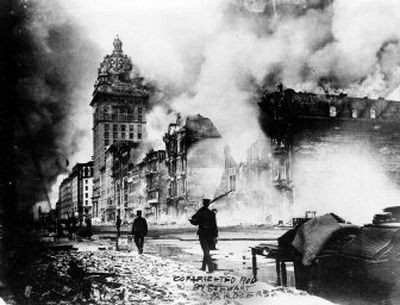City won’t sugarcoat history of 1906 earthquake

SAN FRANCISCO – The year was 1906. The city was demolished by an earthquake. Then ravaged by fire.
San Francisco quickly rebuilt and trumpeted itself as a world-class city gracefully risen from the ashes. What would be remembered through the years were the positives: the heroism, the generosity of neighboring cities, the gorgeous architecture that replaced what was lost.
Hidden in the city’s rewritten history were darker realities.
In the chaos, San Franciscans lashed out at the underclass – beating and shooting Chinese immigrants, in part to keep them from rebuilding Chinatown.
Officials covered up the death count – now thought to have surpassed 3,000 – doctored photographs to minimize the appearance of damage, and removed earthquake faults from maps.
And the upper class illegally took over city government.
A century later, civic leaders are struggling to commemorate one of San Francisco’s defining stories, but one saddled with much loss of life and conflicting interpretations. Complicating the tribute even more is the certainty that another catastrophic earthquake looms in the future.
“I feel sorry for the organizers,” said Tim Hodson, director of the Center for California Studies at California State University, Sacramento. “How do you decide to commemorate a human tragedy that could repeat itself anytime?”
Fault lines emerged early.
One historian has insisted that the events should be marked with solemnity, in honor of the thousands of dead the city only recently acknowledged officially. San Francisco’s Chinese community is emphasizing the era’s historical atrocities.
As in 1906, business interests are stressing a debatable, feel-good story line that highlights the city’s continuing comeback as a global competitor.
And with memories of Hurricane Katrina still raw, donors are focusing on seismic preparedness, shunning ideas based on celebrations.
Mayor Gavin Newsom, 38, offered his own idea: a party with local rock hero Carlos Santana. It was scuttled when donors worried that a concert would be in poor taste.
A smattering of events slowly have taken shape around a judiciously balanced theme – “Commemorate, Educate and Celebrate” – including an earthquake expo and the city’s belated embrace of a memorial gathering held annually at a downtown fountain.
Newsom acknowledged that the 1906 earthquake was an “awkward” event to mark.
“Do you sit there with a candlelight vigil and say, `My God, how dare the city do what it did back then, with the corruption of city officials or the mistreatment of its Chinese American residents?’ ” he said.
“Do you sit there and tell people, `Why are we all here? The next earthquake is going to come, and most of us are not going to make it.’ Or do you focus on the city’s comeback and rebuilding?”
Until the earthquake’s 100th anniversary approached, San Francisco had done little to commemorate the historic event.
For decades, a small gathering of survivors have observed the day at Lotta’s Fountain, an ornate, downtown landmark that in 1906 served as a message board for the dispossessed.
Historian Gladys Hansen was turned down by the city when she wanted to erect a memorial to victims; she had to turn to a cemetery in nearby Colma.
But the centennial was a marker the city could not ignore. Newsom created a committee two years ago to organize what he promised would be a world-class observance. But only in the last few months did any plans begin to take form.
As the main event, the city officially has embraced the Lotta’s Fountain gathering, and tens of thousands of people are expected on April 18, along with 18 survivors. A moment of silence will mark the quake and will be shattered at 5:13 a.m. when fire stations sound their sirens and churches ring their bells.
Also planned are a parade, firefighters costume ball and a $500-a-plate dinner to benefit the San Francisco Museum and Historical Society and the Chinese Historical Society of America.
Despite the initial criticism, the city’s centennial organization, called San Francisco Rising, is not shying away from all negative imagery.
It supports the Chinese historical society, which will remind residents of some of San Francisco’s darkest moments through a one-man theater production and exhibit.
The city also will be the site of three conferences for seismic professionals. Safety and preparedness education will occur in schools throughout the year.